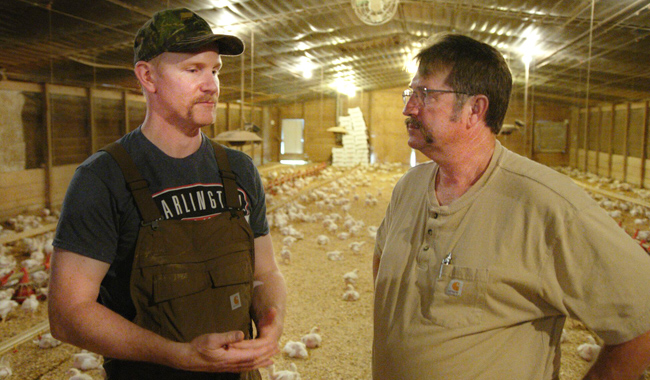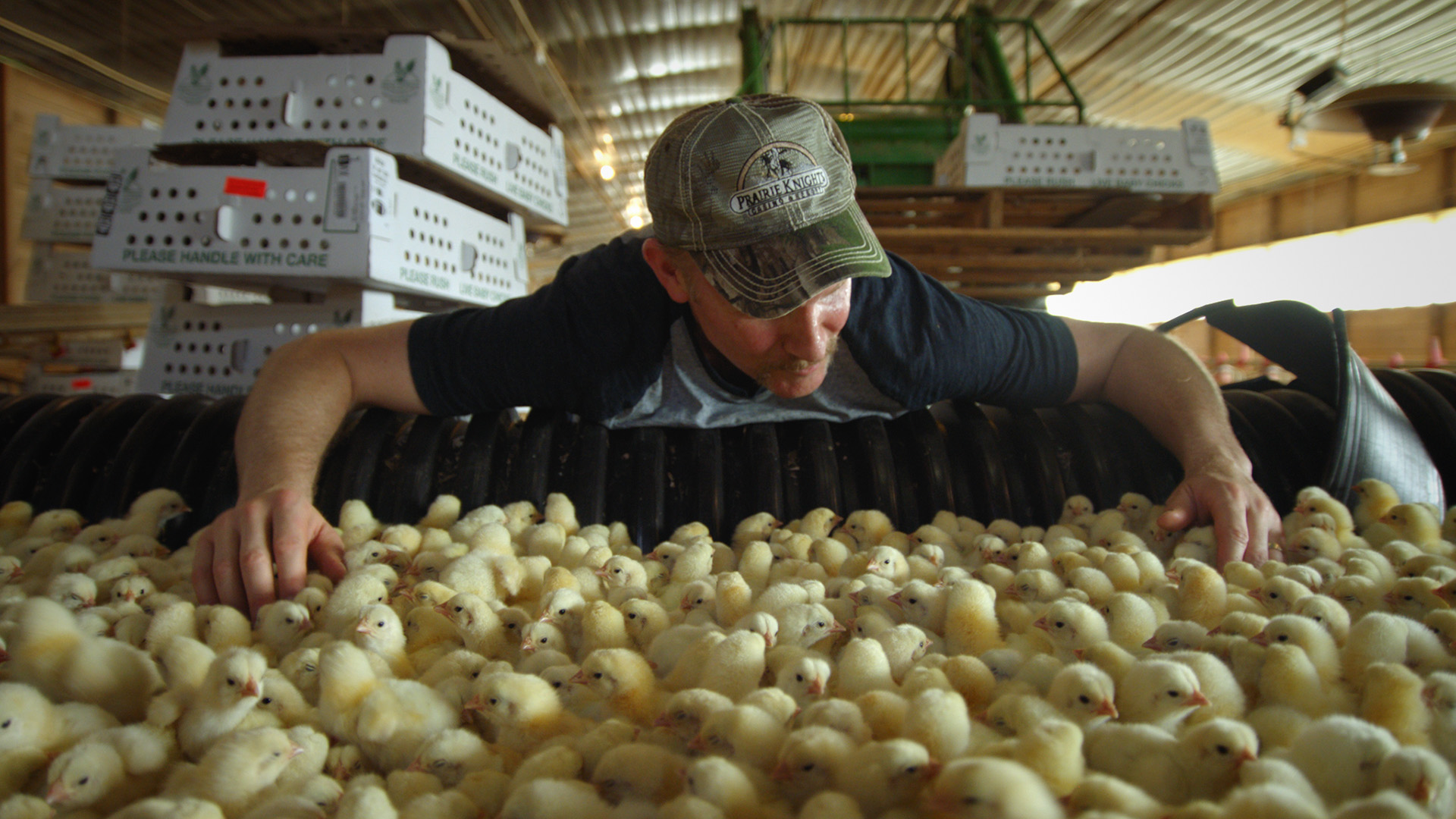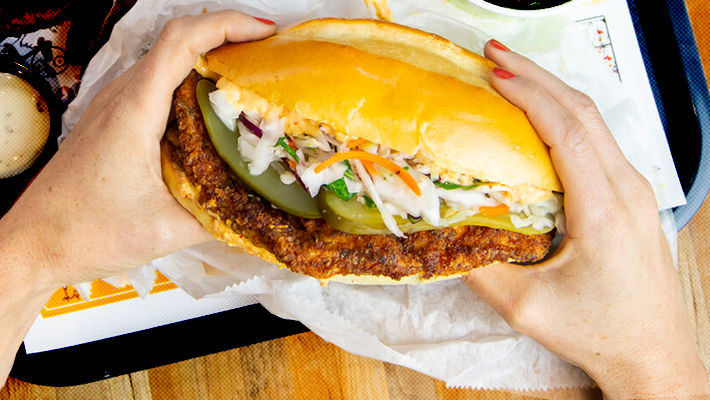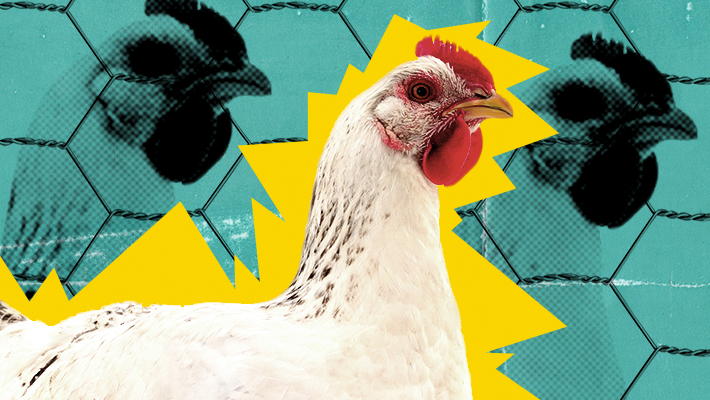In Super Size Me 2: Holy Chicken, director Morgan Spurlock is only medium coy in tracing the current fast food trends towards healthy-sounding food back to… himself, and to Super Size Me, the unlikely 2004 hit that turned the cuddly documentarian into a star and led McDonald’s to stop asking people if they would like to “supersize” their meals.
Fast food is different in 2019, or so they’d have us believe — full of verdant green walls and rustic wood grain, packed with “healthy” terms like “fresh,” “hand-made,” “no hormones added,” “free-range,” “artisan,” etc. And so, in his latest effort, the mustachioed food botherer sets out to separate fast-food truth from marketing.
Spurlock’s shtick — and how much you enjoy Spurlock largely depends on your tolerance for shtick — once again centers on a stunt of sorts. In the sequel, he’s opening his own fast-food chicken restaurant (“Holy Chicken”). Not only that, but he’s trying to raise the chickens himself. Oh, and his plan is for all the advertising to be 100% truthful.
I can understand Spurlock’s brand of kitsch grating on some people, or thinking the idea of “stunt docs” is outdated, but the truth is, Spurlock is still a charming narrator (at least to me), and his “stunts,” whether they be eating McDonald’s for a month or opening a “100% honest” chicken restaurant, are transparently framing devices for a larger story. He’s simply taking important information about the nation’s food supply that’s already out there in some form and trying to give it a user-friendly “hook” — to package it in a way that the average American will care about. And we should care. Just this week the Trump administration put the finishing touches on a plan to essentially let the pork industry inspect itself.
If there’s a flaw to Spurlock’s approach, it’s that he seems to focus an awful lot on the consumer choice aspect of reforming the corporatized food economy, when it seems clear that there’s a limit on what “voting with our dollar” can actually accomplish, in the absence of meaningful policy reform. Nonetheless, Super Size Me 2: Holy Chicken, which played theaters in bigger cities earlier this month and is now on VOD, is full of information we should definitely know and probably don’t, about our favorite protein.
In particular, it sheds some light on “Big Chicken” — the cabal of vertically-integrated corporations that control 99% of the industry — and how those companies leverage their power to squeeze independent chicken farmers. We learn that the industry presides over a “tournament system,” which was supposed to reward better quality chicken, but in practice is a way to enforce rigid standards and to punish and blackball any farmer who steps out of line.
Later, Spurlock exposes how damn near impossible it is to grow chicken independently, through the lens of trying to do it himself. His film is at once an exposé, a publicity stunt, and a plea for transparency. But transparency can be a tricky thing, and before the film could be released, Spurlock became a poster boy for the limitations of what transparency can accomplish.
Holy Chicken was largely shot in 2016 and played the festival circuit in 2017. That Spring, TNT announced that Spurlock would join Sarah Jessica Parker for a show focusing on issues facing women and the #MeToo movement. But before it had been shot, Spurlock released a confession on Twitter, in which he admitted to a rape accusation from his college days, copped to a previously-settled sexual harassment allegation at his production company, and said he had “been unfaithful to every wife and girlfriend I have ever had.” His admission, he said, was part of an attempt to be better. But the fallout was swift, and within the week Holy Chicken had been dropped by its distributor, YouTube Red, and Spurlock had split with his own production company. Eventually, he had to pay TNT $1.2 million after the show was scuttled.
It’s naive, to be sure, to assume that confessing wrongdoing automatically gives you immunity from its consequences, but it’s hard to compare the fallout from Spurlock’s voluntary confession to, say, President Trump’s repeated denials and not come away thinking that honesty is a sucker’s play.
Which is just to say, as much as there was to talk about chicken when we spoke, I wanted to ask him about transparency in his own life too. To his credit, we spoke without ground rules and he didn’t seem upset when I raised the subject. We probably didn’t make much headway there, but we made some progress on chicken.
Okay, so at the end of the movie, the title card said you were taking calls from investors [wanting to invest in the Holy Chicken restaurant concept]. How much have you made it into a real restaurant since then?
Well, what’s happened now is we were using this as a chance to reignite the conversation around it, and it’s still there. There’s still a group of investors that we’re talking to and the goal is to move Holy Chicken forward. So we’ll see. It’s probably something we’ll be talking about over the next week or two.
And what would be the goal with that?
I mean, listen, I think the thing that’s most damning in the movie is the number of independent chicken farmers that there are in America. You see people like Johnathan and Zach [Buttram, two chicken farmers featured in the film] and others who are continuing to be forced out of the industry. They’re under the thumb of big chicken and are carrying hundreds of thousands if not millions of dollars worth of debt. 99% of the chicken that you and I eat comes from five companies. 1% comes from independent chicken farmers like Johnathan and Zach. So anything that we could do to swing that pendulum a tiny bit, to create more independent chicken farmers out there that don’t have to rely on these big vertically integrated corporations that are taking advantage of them, that would be the biggest goal.
Can you explain why it’s so hard for an independent rancher to get into the chicken farming business in the first place?
Well, for one because it’s impossible to get eggs. You saw in the film how hard it was for me just to get chickens. In the end, I was able to get 2,600 chickens. That place where we got them, we could have gotten… I think the guy at Murray McMurray said we could have potentially gotten up to 8,000 birds, maybe 10. So now that’s one guy giving us one flock of birds, 10,000, at one chicken farm, right? One big chicken grower on one big chicken farm can raise 30,000-plus birds in these barns. Some farms have 10 birdhouses on them, so that’s 300,000. And so if the maximum that you could even be able to get as an independent is 10,000, it becomes very difficult to compete with big corporatized chicken. So that’s one.
Problem number two is, once I’ve raised my birds, independent slaughterhouses are also almost non-existent. To find a slaughterhouse where you can actually get your birds prepped to go to market is very difficult. So I found an independent slaughterhouse, but it was based in Kentucky. I raised my birds in Alabama. So I had to truck my birds to Kentucky, then sell to my restaurant in Ohio. Everything has been bought up by these corporations to create what they call a vertically integrated system. Just those two hurdles make it virtually impossible for a layman or an independent farmer to come in. You have to almost come in and create your own vertically integrated system.

And why would the independent system create better chickens?
While we made this film dozens and dozens of chicken farmers, all they talked about was how much they didn’t want to be working for these corporations. How they’d love to raise birds the way that they’re meant to and not forced into a contractual obligation of having to raise them in a way that ultimately is not best for the birds. I think there’s, and Johnathan and Zack will be the first ones to tell you, there is definitely a better way. Where you can create what is, essentially, a free-roaming bird. A bird that will go outside. A bird that lives its life like a normal chicken would, that isn’t bred to go from egg to bun in six weeks.
I think that it’s one of things where you have to have some backers and some money that will enable you to start the process. Our hope is and belief is that potentially a restaurant that can supply its own demand would be the way to do that.
You focus a lot on the advertising and branding of big chicken and the health halos and that stuff in the film, and it feels like there’s a public education aspect of it. But isn’t there a limit to how much consumer choice can accomplish here? Isn’t this partly an issue of policy?
In what aspect?
Just in terms of when you’re talking about big chicken having a hold on everything. How much can we as a consumer be expected to know, and how much can our choices solve some of the problems with that?
I mean, I think you’re hitting the nail on the head. Ultimately, at the end of the day, it’s a consumer choice. But at the same time, there aren’t choices that are lowering the bar. To put a free-roaming bird out on the market right now, the companies that are doing that, they’re selling for extraordinary prices by comparison. You’re looking at chickens that are anywhere between $15 and $30. So to buy a chicken for $30 where, ultimately, I can go down to the Piggly Wiggly or the Ralph’s and get a chicken for $5… that’s a huge difference.
And so that type of cost versus value is where we start to make sacrifices. We’ll just buy something. Well, it may not be free range, but it’s affordable. So if there’s a way to kind of not make people have to sacrifice quality, while at the same time feeling like they’re actually making a choice that is better for them and for the environment, that’s a great first step. I live in New York City, and I’m fortunate that farmers come into the city every weekend for farmer’s market and I can walk down to the farmer’s market and literally buy a chicken from the guy who raised it in upstate New York.
I grew up in West Virginia. You could actually find chicken farmers where you could buy the birds that lived down the road. But a lot of us may not be in that situation. So then what do you do? And it’s kind of understanding the misinformation that’s on a label and actually what that represents. And the film does a great job of dissecting that. We want to believe that the government is looking out for us, that corporations are there to protect us, that “free range” actually means we’ve got these chickens who are having this magical kind of bucolic life running around out in fields, and that’s just not the case.
Yeah, let’s talk about the labels on supermarket chicken. Which labels actually mean something, and which ones are 90% bullshit?
Well, most of the labeling is bullshit. I mean, that’s what you see in the film. Natural means nothing because everything occurs naturally, you can call just about everything in the world a natural product. Cage-free doesn’t mean anything for a chicken because broiler chickens aren’t raised in cages. Antibiotic-free doesn’t mean anything because we live in a country where you’re not allowed to give antibiotics to the chickens while they’re being raised. So that is a complete misrepresentation. And then you have “free-range.” It’s a USDA-managed term, but there are no regulations in terms of specifically what that is defined as. You see me on the phone in the film with the USDA where they say the definition means they only have to have access to the out of doors, for up to 51% of their life. So all we did was open up a door, put up a little grate, basically a five-by-five area space, and suddenly these birds were free-range. They don’t have to walk outside. They don’t have to ever go into that area. Just by them having access or the ability to go outside makes them a free-range chicken, which is crazy to think about.

Right. And it’s great if we know what these terms mean and we’re getting educated on that. But how much can we expect consumer choice alone to solve? In terms of changing that system, wouldn’t it be better if there were changes at the policy level that changed how big chicken operated and what they were required to do?
100%. You and I are in complete agreement about that. The problem when it comes to policy is that the people who make the policies are people who usually came from the chicken companies. People who go to places like the USDA or the FDA, these are folks who worked at the corporations who then move into the regulatory commissions. While they’re there, they pass bills and laws that changed the regulations, that are much more in favor of the corporations than they are for consumers. These people end their terms, then they go back to work for these corporations again, making millions of dollars. It is a vicious cycle. So what needs to happen? Well, the biggest thing that needs to happen is there’s got to be, one, changes to how you can actually influence politics. And there’s so much big money in it, and it’s not just the food system.
It’s also in oil, the environment. It’s across the board, this kind of revolving door of corporate interests coming in to define the regulations. What you hope is on the heels of a film like this, when you see how these farmers live, when you see how kind of misled we continue to be, that people will start to want to act up a little bit, reach out, write letters, make phone calls, stand up for these chicken farmers, and seek out better products.
Did you change anything about the film in the time since it originally played the festival circuit in 2017?
I mean, the sad part about our food system is that it’s not like anything has changed in the way chickens are raised or in the way farmers are treated. In fact, Johnathan Buttram, the farmer in the film, has said in the two years since then, it’s gotten even worse. They are being squeezed even more. So for me, I think that I’m incredibly happy that the film is coming out now and it makes me really pleased that the farmers are finally going to get to have their voices heard.
This movie’s all about transparency and trying to achieve that. And then you were making a show about the Me Too movement, and you came forward about some things in your past. In facing the consequences that you did, do you feel like that sort of shows some of the ways that we punish transparency?
Yeah. I mean, I think that we live in a time where if you look at everything that’s happened around that movement, the mission for anybody is these guys come forward. And I think it was really important for me to basically say, “I’m a person who’s made mistakes in my past. I’m somebody who has made it a point to tell the truth in my work. And I recognize that I can do better.” And I think that we live in a world right now where we encourage people to lie consistently and aggressively, simply for self-preservation. And I think that that is a very wrong message to be sending.
Okay, so I guess the big question is, now that we’ve seen this movie and we know how the chicken supply chain works, what do we do as a consumer?
I think the biggest thing as a consumer you need to do is to try to support more independent chicken farmers. Try and find a local farmer, a local purveyor or somebody where you can get your birds from. I think that you need to stand up against big chicken. You need to make a stink and talk to your representatives. You need to make sure that these independent farmers are heard.
And [laughs] probably the best thing you could do is go down and get yourself a delicious grilled crispy chicken sandwich from Holy Chicken. What better way to fight the man than with a delicious sandwich like that?
Sure. Okay. So what do I Google to find myself an independent chicken farmer to buy chickens from?
I would start right there. Where do I buy independent chickens near me? And there’s a bunch of different organizations that are working to do nothing but give you an opportunity to do that. And part of what I hope we can do is get more information out there where people understand exactly who they can buy those birds from, and they’re kind of not stuck in this big chicken loop.

Some of the organizations Morgan recommends checking out:
The American Pastured Poultry Producers Association
Vince Mancini is on Twitter. You can access his archive of reviews here.







